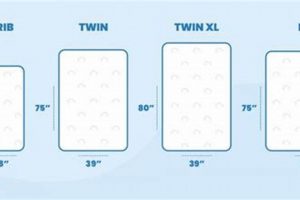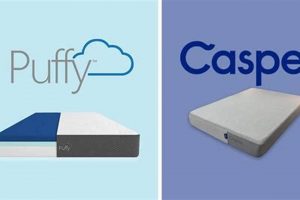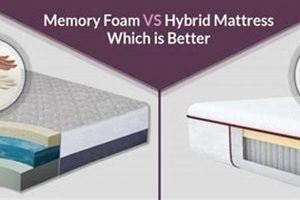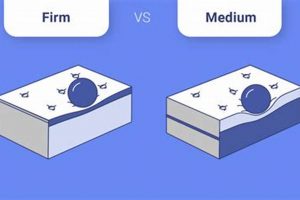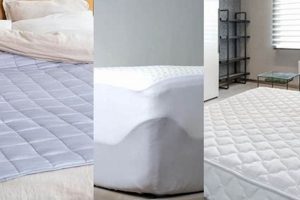A comparison of two prominent mattress brands, Nectar and Casper, reveals distinct approaches to sleep technology and consumer comfort. Nectar emphasizes memory foam construction, often prioritizing body contouring and pressure relief. Casper, conversely, typically incorporates a hybrid design, blending foam layers with innerspring systems for enhanced support and bounce. This contrast in construction is a central aspect of any comparison.
Choosing between mattresses requires careful consideration of individual needs and preferences. Factors such as sleeping position, body weight, and desired firmness level significantly influence the optimal choice. Furthermore, understanding the materials used and the construction techniques employed provides valuable insight into the long-term durability and performance of each mattress. Brand reputation, warranty offerings, and trial periods further contribute to informed decision-making.
The subsequent sections will delve into a detailed examination of these two options, covering aspects such as construction materials, firmness levels, temperature regulation capabilities, motion isolation properties, and price points. This analysis aims to equip potential buyers with the information necessary to make a well-informed decision based on their specific requirements and priorities.
Considerations for Mattress Selection
Selecting a mattress requires careful evaluation of individual needs and product specifications. The following tips aim to guide the decision-making process when considering brands like Nectar and Casper.
Tip 1: Assess Sleeping Position. Side sleepers often benefit from mattresses with enhanced pressure relief, particularly in the shoulder and hip areas. Back sleepers typically require a balance of support and cushioning. Stomach sleepers generally need firmer surfaces to maintain spinal alignment.
Tip 2: Evaluate Firmness Preferences. Firmness is subjective. Factors such as body weight influence how a mattress feels. Heavier individuals may perceive a mattress as softer than lighter individuals. It is crucial to consider personal comfort preferences alongside objective firmness ratings.
Tip 3: Investigate Material Composition. Different materials offer varying levels of support, pressure relief, and temperature regulation. Memory foam excels at contouring, while innerspring systems provide a more traditional bounce. Hybrid mattresses combine these features.
Tip 4: Consider Temperature Regulation. Overheating can disrupt sleep. Mattresses incorporating breathable materials or cooling technologies can mitigate this issue. Look for features like gel-infused foams or open-cell structures.
Tip 5: Examine Motion Isolation Capabilities. If sharing a bed, motion isolation is a crucial factor. Mattresses with superior motion isolation minimize the transfer of movement across the surface, reducing sleep disturbances.
Tip 6: Analyze Edge Support. Strong edge support prevents sagging and facilitates getting in and out of bed. This feature is particularly important for individuals who sit on the edge of the bed or require assistance with mobility.
Tip 7: Review Warranty and Trial Period. A generous warranty and trial period provide an opportunity to test the mattress in a real-world setting and assess its suitability. Understand the terms and conditions of both before making a purchase.
By carefully considering these factors, individuals can make a more informed decision and select a mattress that aligns with their specific needs and preferences, enhancing sleep quality and overall well-being.
The subsequent sections will summarize this guide, and provide the concluding statements.
1. Construction Materials
The choice of construction materials directly impacts the performance characteristics of mattresses, particularly when considering options such as Nectar and Casper. The materials dictate factors such as firmness, support, temperature regulation, and durability. Nectar mattresses commonly utilize memory foam, which offers significant body contouring and pressure relief. However, traditional memory foam can retain heat, potentially leading to discomfort for some sleepers. Casper mattresses often employ a hybrid design, incorporating layers of foam alongside innerspring systems. This construction aims to balance comfort with support and improve airflow.
A key example of this material influence is observed in temperature regulation. While Nectar may incorporate gel-infused memory foam to mitigate heat retention, the overall density of the foam layers can still limit airflow compared to the coil system in a Casper hybrid. This difference can be particularly relevant for individuals who sleep hot or live in warmer climates. Similarly, the innerspring component of a Casper mattress contributes to edge support, which can be less pronounced in an all-foam Nectar design. The specific types of foam (e.g., polyfoam, memory foam, latex foam) and the gauge of the coils used also exert significant influence on the feel and longevity of each mattress.
In summary, understanding the construction materials used in Nectar and Casper mattresses is fundamental to predicting their performance and suitability for individual needs. Material choices dictate a mattress’s primary characteristics, and therefore, influence the overall sleep experience. Consideration of material properties alongside individual preferences is essential for informed decision-making.
2. Firmness Level
Firmness level is a critical differentiator when evaluating Nectar and Casper mattresses, directly influencing spinal alignment, pressure relief, and overall sleep comfort. Different firmness levels cater to various sleeping positions and body types. A mattress that is too soft may cause spinal misalignment for stomach sleepers, while one that is too firm may create pressure points for side sleepers. Therefore, an accurate assessment of firmness is crucial for selecting the right mattress.
Nectar mattresses, generally known for their memory foam construction, often exhibit a medium-firm feel. This translates to a balance between contouring and support, accommodating a range of sleeping positions, although potentially less ideal for heavier individuals who may require firmer support. Casper, with its hybrid design, typically offers options across a broader spectrum of firmness levels. This allows consumers to select a mattress that more precisely aligns with their individual preferences. For example, a lighter individual might find the Nectar mattress perfectly suitable, whereas a heavier individual or stomach sleeper may prefer a firmer Casper model.
In summary, firmness level significantly impacts the perceived comfort and support offered by both Nectar and Casper mattresses. While Nectar tends towards a medium-firm feel, Casper provides a wider array of firmness choices to accommodate diverse needs. The ultimate decision depends on the individual’s sleeping style, body weight, and personal comfort preferences. Understanding this relationship is paramount for making an informed mattress purchase that promotes restful and restorative sleep.
3. Temperature Regulation
Temperature regulation is a critical factor influencing sleep quality, and its effectiveness varies significantly between different mattress designs. When considering Nectar and Casper, understanding their respective approaches to temperature management is essential for informed decision-making. The materials and construction techniques used by each brand affect heat retention and airflow, impacting the overall sleep experience.
- Material Composition and Breathability
Nectar mattresses primarily utilize memory foam, known for its contouring properties but also its tendency to retain heat. The density of memory foam restricts airflow, potentially leading to elevated sleeping temperatures. Conversely, Casper often employs a hybrid design, combining foam layers with innerspring systems. The presence of coils allows for greater airflow, facilitating heat dissipation. The specific types of foam used, such as open-cell memory foam, can further influence breathability.
- Cooling Technologies and Infusions
To address heat retention, some mattress manufacturers incorporate cooling technologies. Gel infusions within the foam layers are intended to draw heat away from the body. Phase change materials (PCMs) are also used to absorb and release heat, regulating surface temperature. While both Nectar and Casper may utilize these technologies, their effectiveness can vary based on the concentration and distribution of the cooling agents within the mattress.
- Mattress Cover Design
The mattress cover plays a crucial role in temperature regulation. Breathable fabrics, such as cotton or specialized performance textiles, promote airflow and wick away moisture. Denser, less breathable covers can impede heat dissipation. The construction and materials of the mattress cover should be considered alongside the internal components when evaluating temperature regulation capabilities.
- Environmental Factors and Individual Physiology
External factors, such as ambient room temperature and bedding choices, significantly impact sleep temperature. Individual physiology also plays a role; some individuals naturally sleep hotter than others. Therefore, even with a temperature-regulating mattress, maintaining a cool sleep environment and using breathable bedding materials are essential for optimal comfort. The effectiveness of a mattress’s temperature regulation features must be considered in conjunction with these external influences.
Ultimately, the effectiveness of temperature regulation in Nectar and Casper mattresses depends on the interplay of material composition, cooling technologies, mattress cover design, environmental factors, and individual physiology. Understanding these interconnected elements allows consumers to make a more informed choice based on their specific needs and preferences.
4. Motion Isolation
Motion isolation, the ability of a mattress to minimize the transfer of movement across its surface, is a significant factor for couples or individuals sharing a bed. The effectiveness of motion isolation directly impacts sleep quality by reducing disturbances caused by a partner’s movements. A comparative analysis of Nectar and Casper mattresses requires considering their respective motion isolation capabilities due to their differing construction.
- Foam Density and Composition
Nectar mattresses, typically constructed with memory foam, generally excel in motion isolation due to the foam’s dense structure, which absorbs movement. This limits the propagation of disturbances across the mattress surface. Casper, with its hybrid design, may exhibit slightly less effective motion isolation compared to all-foam Nectar models, as the innerspring system can transmit some movement. However, the specific types and densities of foam used in Casper’s construction can mitigate this effect.
- Layer Construction and Arrangement
The arrangement of foam layers within a mattress can significantly influence motion isolation. Mattresses with multiple layers of high-density foam tend to perform better at absorbing movement. Nectar’s layered memory foam design contributes to its motion isolation performance. Casper’s layering strategy, which combines foam with coils, aims to balance support and comfort while minimizing motion transfer, but the effectiveness is contingent on the specific layer configuration.
- Edge Support and Movement Containment
While edge support primarily addresses structural stability, it can indirectly affect motion isolation. Mattresses with reinforced edges tend to contain movement more effectively within the sleeping surface. Edge support varies between Nectar and Casper models, depending on their construction. Stronger edge support enhances the perception of motion isolation, as it prevents movement from radiating outwards.
- Real-World Sleep Disruption
The practical impact of motion isolation is most evident in reducing sleep disruptions caused by a partner’s tossing and turning, getting in and out of bed, or differences in sleep schedules. Superior motion isolation minimizes these disturbances, leading to improved sleep quality for both individuals. The degree to which Nectar or Casper mattresses provide this benefit depends on the factors outlined above, as well as individual sensitivity to movement.
In conclusion, while both Nectar and Casper aim to minimize motion transfer, their differing construction methods result in varying levels of performance. Nectar’s memory foam construction typically provides excellent motion isolation, while Casper’s hybrid design aims to balance motion isolation with other performance characteristics. The optimal choice depends on the specific needs and priorities of the individuals sharing the bed, particularly their sensitivity to movement and tolerance for sleep disruptions.
5. Price Point
The price point is a critical determinant in the consumer’s evaluation of Nectar and Casper mattresses. It represents the financial investment required and directly influences the perceived value proposition. Discrepancies in pricing between the two brands, or among different models within each brand’s lineup, often reflect variations in materials, construction complexity, and technological features. The price point, therefore, becomes a central component of the purchasing decision, weighed against the anticipated benefits and performance characteristics of each mattress.
For instance, Nectar mattresses, frequently marketed with aggressive promotional pricing and bundled offers, often present a lower initial cost compared to Casper. This can be a significant factor for budget-conscious consumers. However, the lower price may correlate with differences in material quality or longevity compared to more premium Casper models. Conversely, Casper mattresses, particularly those incorporating advanced cooling technologies or hybrid designs, may command a higher price point. This price reflects the enhanced features and potentially longer lifespan, appealing to consumers prioritizing long-term value and advanced comfort. Real-life examples consistently demonstrate consumers balancing budgetary constraints against desired features when comparing these mattress options.
In conclusion, the price point is inextricably linked to the overall assessment of Nectar versus Casper mattresses. It serves as a tangible metric for evaluating value, prompting consumers to weigh the financial commitment against the anticipated benefits. While a lower price may initially appear attractive, a comprehensive evaluation must consider the long-term cost-effectiveness, durability, and performance features offered by each brand. The informed consumer recognizes the importance of balancing price with value to ensure a satisfactory and lasting sleep experience.
Frequently Asked Questions
This section addresses common inquiries regarding the distinctions between Nectar and Casper mattresses, providing objective information to aid in informed decision-making.
Question 1: What are the primary construction differences between Nectar and Casper mattresses?
Nectar mattresses typically feature all-foam construction, predominantly utilizing memory foam layers. Casper mattresses often employ a hybrid design, combining foam layers with an innerspring coil system for enhanced support and responsiveness.
Question 2: How do Nectar and Casper mattresses compare in terms of firmness?
Nectar mattresses generally offer a medium-firm feel, catering to a broad range of sleeping positions. Casper provides a wider selection of firmness options, allowing consumers to choose a model best suited to their individual preferences and needs.
Question 3: Which mattress brand, Nectar or Casper, is better for temperature regulation?
Casper mattresses, particularly those with innerspring systems, tend to offer superior temperature regulation due to improved airflow. Nectar mattresses may incorporate cooling technologies, but the all-foam construction can still restrict airflow compared to hybrid designs.
Question 4: How effective are Nectar and Casper mattresses at isolating motion?
Nectar mattresses, with their all-foam construction, generally excel at motion isolation, minimizing the transfer of movement across the surface. Casper mattresses offer good motion isolation, though not typically to the same extent as all-foam models, due to the presence of innerspring coils.
Question 5: What is the typical price range for Nectar and Casper mattresses?
Nectar mattresses frequently offer competitive pricing, often positioned as a more budget-friendly option. Casper mattresses may command a higher price point, particularly for models with advanced features or hybrid designs. Price variations exist within each brand based on mattress size and specifications.
Question 6: How do the warranty and trial periods compare between Nectar and Casper?
Both Nectar and Casper offer generous warranty and trial periods, allowing consumers to test the mattress in a home environment. The specific terms and conditions of these offerings should be carefully reviewed before purchase, as they may vary.
The preceding answers provide a concise overview of key differences between Nectar and Casper mattresses. A thorough understanding of these distinctions empowers consumers to make informed decisions aligned with their individual needs and preferences.
The subsequent section will offer a summary of the aforementioned points and propose final advice regarding the selection of the products.
Nectar Mattress vs. Casper
This examination of Nectar and Casper mattresses underscores the importance of aligning product features with individual sleep preferences. The core distinctions lie in construction materials, firmness profiles, temperature regulation capabilities, motion isolation properties, and price points. Nectars emphasis on memory foam generally prioritizes body contouring and affordability, while Casper’s hybrid designs often offer a balance of support, responsiveness, and enhanced airflow.
Ultimately, the selection necessitates a thorough self-assessment and critical evaluation of product specifications. Prospective buyers are encouraged to consider their sleeping position, body weight, and sensitivity to motion transfer. A well-informed decision, grounded in a clear understanding of personal needs and product attributes, will contribute to an improved sleep experience and long-term satisfaction. Prioritize features that address individual needs to realize the greatest benefit.


![Leesa vs Casper Mattress: Which Bed is Best [2024]? Organic & Natural Mattress Buyer’s Guide: Non-Toxic Sleep Solutions Leesa vs Casper Mattress: Which Bed is Best [2024]? | Organic & Natural Mattress Buyer’s Guide: Non-Toxic Sleep Solutions](https://mattressworldpa.com/wp-content/uploads/2025/07/th-1078-300x200.jpg)
